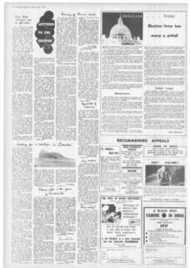Page 1, 3rd June 1966
Page 1

Page 9

Report an error
Noticed an error on this page?If you've noticed an error in this article please click here to report it.
Tags
Share
Related articles
Tito Turns On The Heat
News From Tito's Yugoslavia Is Of :
Visit Off: Row With Italy
Yugoslavia And The New Pact
New Pact May Lead To Links With East
Vatican Tito pact is ready for signing
THREE MAIN TERMS
FROM OUR SPECIAL CORRESPONDENT IN ROME
THE Vatican and the Yugoslav Government have reached an agree
ment on the renewal of diplomatic relations. It awaits only the signatures of Pope Paul and President Tito. The main point of the agreement is that the Government and the Church in Yugoslavia will from now on fully recognise each other's respective authority.
It will also lead to the resumption of Vatican-Yugoslav relations on an "appropriate international occasion". This is believed to mean that an official announcement will follow on the Italian administrative elections, set for June 12-13.
According to informed and reliable sources here, there are three main terms of the agreement. The first is on Yugoslav Church-State relations, the second is the kind of renewed relations to be taken up between the Vatican and Yugoslavia, and the third, practical regulations for the new diplomatic officials that will be created.
1. Inside Yugoslavia, ChurchState relations will be controlled by the constitution and laws as they exist under President Tito's Government, and the Church and State authorities must themselves resolve any quarrels between them.
'Ibe Government a 1 s o guarantees to give full force to the existing laws under which Catholics are free to run semi naries, have a free press and freedom of worship.
2. The renewed VaticanYugoslav relations will be carried through by "special representatives"—that is, not by ambassador and Papal nuncio. Their status will be similar to that of the United States representative at the Vatican, Myron Taylor, in World War II.
Yugoslav initiative
3. Practical details of the new representative service have yet to be agreed on.'One question is whether the diplomatic officials in Rome and in Belgrade will bring their own staff with them, or will have to take on staff on the spot.
Another is whether the offi
cials will have diplomatic immunity, and how their position will tie up with the diplomatic corps.
The agreement has been brought about through the initiative of a Yugoslav delegation led by the undersecretary in the Ministry of Foreign Affairs, M. Ivicevic. The Vatican negotiators were led by Monsignor Agostino Cesar°li and Monsignor Luigi Bongianino of the Secretariat of State.
The talks are delicately placed in the setting of the Italian election campaign, for the Communists are aiming to plant the hammer and sickle on the Campidoglio, Rome's city hall. giving them propaganda material in 11...e agreement with Italy's Communist neighbour.
At the same time, the Yugoslav Communist Party is willing to support its Italian comrades. , It is noticeable that among Italian newspapers the Communist and crypto-Communist press has been the best informed on what is going on between the Vatican and Yugoslavia.
In some Vatican circles there is criticism of the whole agreement as "a new non-success of Vatican diplomacy". It is said that the Church is not getting any advantages from the agree ment, and that in such a case a Communist Government will be only too ready to conclude it.
The Vatican critics of the negotiations complain also of the fact that the Yugoslav Government first submitted the agreement to the Council of the Yugoslav Orthodox Church for their approval.
And they forecast that Yugoslavia will take up the Hungarian practice, where the Government is said to take action against priests hostile to the regime by ordering Bishops to discipline them.
of the new agreement, it is said that the Vatican-Yugoslav dialogue should make sure that the present Yugoslav laws on religious rights are carried out more effectively.
On top of this, the renewed relations mean that any future business between the Vatican and Yugoslavia will have an internationally recognised force.
Since 1948, relations have been practically non-existent. The formal break came in 1952 as a protest against the appointment of Archbishop Stepinac of Zagreb to the Cardinalate.
The Vatican replied to President Tito's charges of interference in Yugoslav internal affairs. But the letter was returned unopened to the Papal nunciature in Belgrade.
After the death of Cardinal Stepinac in February, 1960, relations began to improve. Pope John, in saying a Requiem Mass for the Cardinal, made an appeal for calmer relations.
The Yugoslav conference of Bishops. in September of the same year, declared its loyalty to the regime. At the same time, it defined certain measures which it believed necessary to normalise relations between Church and State.
Led by Cardinal Seper, successor to Cardinal Stepinac at Zagreb, the Bishops went to
the Vatican Council without hindrance from their Government.
On January 14, 1965, the Yugoslav ambassador to Italy. No Vejvoda, had a special audience with Pope Paul in order to thank him for the Vatican aid to the earthquake victims of Skopje and the flood victims of Zagreb.
But the ambassador seized the opportunity to make an explicit request for renewed relations between the two. Pope Paul welcomed the proposal. Later that month, Monsignor Casaroli visited Belgrade. And the negotiations went on from there.
The Vatican is nervous of
blog comments powered by Disqus











